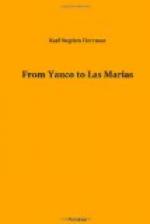If you will take a map of Puerto Rico and cut off the western section by drawing a line from Guanica through Lares to Camuy, you will see at once the extent of the territory brought under American control by General Schwan. The principal towns of this section, in addition to those already described, are Aguadilla, Maricao, Anasco, Cabo Rojo, Lares, and Las Marias; but none of these places are important enough to call for detailed notice, with the possible exception of the first-named. This city, Aguadilla, while it has a population of only 5,500, is notable as being the most picturesque town on the entire island. It is the capital and port of the surrounding district; and, though the climate is hot, it is remarkably healthful. The site is a stretch of shore facing Mona Channel, between Cape Borinquen and the Rio Culebrinas. Directly behind rises the steep green-crested Jaicoa Mountain, its slopes covered with orange, lemon, and palm trees in bewildering profusion; while half-way to the summit there gushes forth a fairylike, crystal stream, which flows directly through the town before emptying into the bay. An antique church and a little fort of 11 guns, called Conception, add to the scenic beauty of the picture, when viewed from the sea. Tourists will probably spoil this lovely town before the end of another decade, but at present it is a quivering page of romance.
[Illustration: On the Road to Lares.]
[Illustration: The Best Outfit in our Wagon Train.]
Of the facilities for transportation in this part of Puerto Rico, it may be said that they are either extremely good or extremely bad. The former condition prevails generally in the valleys, and the latter among the hills toward the interior. There are several interrupted lines of railroad, and burros are used to a considerable extent by the inland planters; but far the greater part of communication and carriage is accomplished by way of the sea.
Labor here, as elsewhere in the tropics, is to be had very cheaply, but is uncertain, sluggish, and dishonest. A man for plantation work can be hired for almost nothing a day, but he will not earn even that unless he is driven at the point of a machete. The local peon desires to toil no longer than is necessary to obtain the bare wherewithal to fill his belly. Then he dreams away the remainder of the day, smoking the eternal cigarette; perhaps rousing himself sufficiently to pick the strings of a guitar in the cool of the evening—and this, at least, the beggar does well. He is not at all ambitious to improve his condition, and he will never be any better than he is to-day. Probably he will be much worse. He will cut throats and burn haciendas all the gay year round if he is not allowed to gang his ain gait. We are going to reform him, of course; but—the day will come when we shall be ashamed to look Spain in the face. In Cuba this man’s brothers were known as “patriots”; which meant that they were soldiers when there was any work to be done, and laborers when fighting was on hand. In my opinion, they are vicious beasts.




